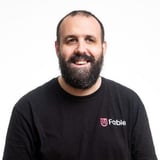Summary
The metaverse, virtual reality, Web 3.0, distributed infrastructure, the Internet of Things, wearable computing, and AI: all these things are going to change the face of accessibility over the next 10 years. In this talk, Samuel Proulx, Fable’s Accessibility Evangelist, will give you an overview of what the current landscape looks like at the frontier of accessibility and assistive technology. Where’s the research taking us? What might be coming down the pipe?
Key Insights
-
•
Early accessibility technologies like the IBM 3767 Braille terminal were expensive and rare, limiting access to a few pioneering users like Sam’s father.
-
•
Hardware text-to-speech systems such as the Echo2 card on Apple II were foundational but costly and limited to command-line interfaces.
-
•
The transition from command-line to graphical user interfaces with Windows 95 introduced major accessibility challenges requiring new techniques for screen readers to interpret visual content.
-
•
Software text-to-speech synthesis replaced expensive hardware devices as PCs grew powerful, enabling more portable and accessible computing devices.
-
•
Assistive technology industry consolidation occurred due to the increasing complexity of accessibility needs post-GUI, exemplified by mergers forming companies like Freedom Scientific.
-
•
Apple’s introduction of built-in VoiceOver on iPhone 3GS marked a paradigm shift by integrating accessibility directly into the OS and developer APIs, eliminating dependence on third-party products.
-
•
Accessibility features initially designed for disabilities benefit all users, such as captions in noisy environments, dark mode, and voice dictation.
-
•
Gaming accessibility remains nascent, relying heavily on third-party modifications and reverse engineering, with little first-party API support.
-
•
Emerging technologies like VR/AR and AI pose novel accessibility challenges, demanding fresh approaches as traditional screen readers and magnification don’t translate directly.
-
•
Sam sees the next big accessibility breakthroughs coming from self-driving cars, neural inputs, and smart home innovations, emphasizing inclusivity across the full disability spectrum.
Notable Quotes
"Nothing about us without us."
"I don’t remember a time when there wasn’t a computer in the house talking at me."
"Accessibility was considered kind of an inspiring hack, an inspirational rarity."
"The GUI transition meant assistive tech had to track cursor, mouse, and graphical objects, making it far more complex."
"Apple unlocked so much innovation by including accessibility in the phone with VoiceOver built-in."
"Accessibility is not only important to preserve rights but leads directly to innovation."
"Accessibility needs are a spectrum, not binary."
"We still think of accessibility as a binary when it should be recognized as a continuum."
"Gaming accessibility is still considered an inspirational hack rather than a built-in feature."
"When we solve accessibility challenges, everyone benefits, not just people with disabilities."
Or choose a question:
















More Videos

"Math by itself can be misleading and full of biases, but combined with humanities research, it can be very powerful."
Scott PlewesWhy Isn't Your UX Approach Going Viral?: A Mathematical Model
March 28, 2023

"People often go along with the outcome if they feel they were part of the process."
Alison Rand Sarah BrooksScaling Impact with Service Design
March 25, 2021

"The power of a bold idea uttered publicly in defiance of dominant opinion cannot be easily measured."
Rachael Dietkus, LCSWThe power to heal and harm
March 13, 2025

"Optimizing something for ease of use does not mean best for the user or humanity."
Sheryl CababaLiving in the Clouds: Adopting a Systems Thinking Mindset
June 6, 2023

"I think the world we’re in is definitely not antagonistic to research, there’s a huge opportunity right now."
Renee BouwensLanding Product Impact: Aligning Research as a Foundational Driver for Delivering the World’s Best Products
December 15, 2023

"We took a little bit more of an editorial approach and kind of trimmed down the tools to keep it legible and usable."
JP Allen Holly HoldenNavigating the UX Tools Landscape
October 1, 2021

"Adjust your conference time zone setting depending on where you are to avoid confusion."
Bria AlexanderOpening Remarks
November 18, 2022

"DeepFakes can look too realistic and might introduce new privacy risks if donor faces come from real people."
Llewyn Paine[Demo] Deploying AI doppelgangers to de-identify user research recordings
June 5, 2024

"Conjoint analysis reveals how consumers make choices by examining trade-offs they are willing to make."
Ricardo MartinsUnlocking the power of advanced quantitative methods
March 12, 2025
Latest Books All books
Dig deeper with the Rosenbot
How should a design ops team define and use lead measures and scorecards to track progress effectively?
What are the benefits of long-term knowledge management for building trust with federal agency partners like the Veterans Experience Office?
How do honeybees organize their work and make decisions without a central leader?
















